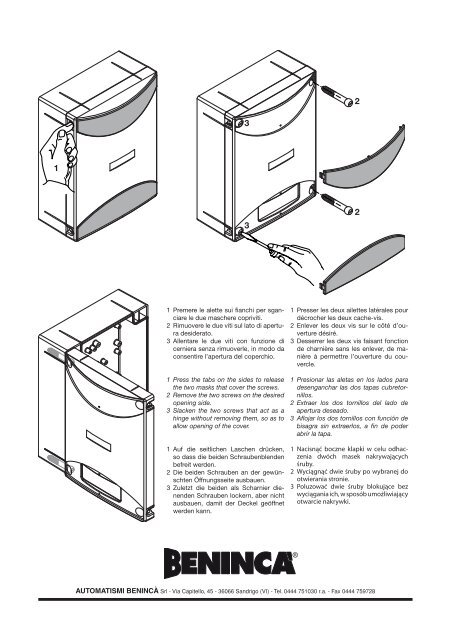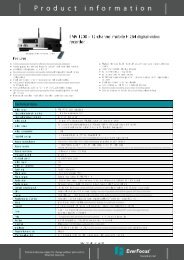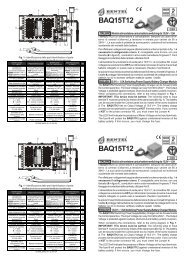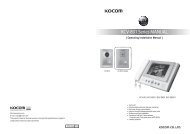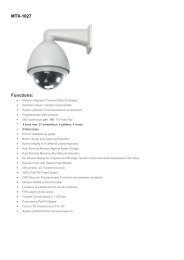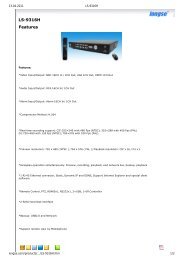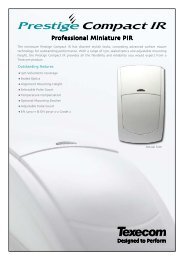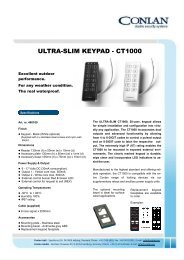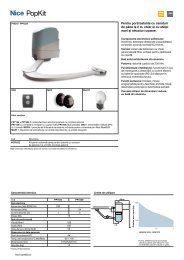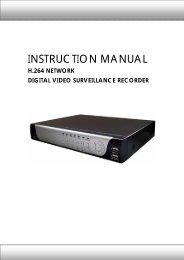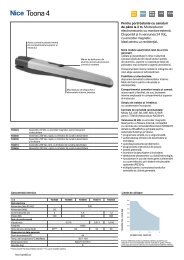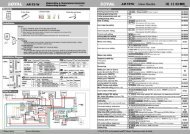Centrala pentru automatizare porti Beninca HEAD - GTO Security ...
Centrala pentru automatizare porti Beninca HEAD - GTO Security ...
Centrala pentru automatizare porti Beninca HEAD - GTO Security ...
Create successful ePaper yourself
Turn your PDF publications into a flip-book with our unique Google optimized e-Paper software.
LED diagnostics<br />
The control unit is complete with a series of self-diagnostics LED’s which allow checking of all functions:<br />
LED PD It switches on when the pedestrian push-button is activated<br />
LED PP It switches on when the step-by-stop push-button is activated<br />
LED SP It switches off when the STOP push-button is activated<br />
LED PH It switches off when photocells are not aligned or when obstacles are present<br />
LED D4 Programming of radio-controls. It is usually flashing to indicate the regular operation of the control<br />
unit.<br />
Advanced programming<br />
The advanced programming permits to activate some special functions:<br />
1) Photocells input, activated in both opening and closure on terminal 22.<br />
In swing gates, it might be useful to connect the inside photocells (columns) to this terminal and connect the<br />
outside photocells to input PHOT (terminal 23).<br />
In this way, the gate opening movement is impaired if the inside photocells detect the presence of an obstacle.<br />
The outside photocells remain, as usual, activated only in the closing phase.<br />
2) Rapid closure activation. If the photocells are passed by, this function carries out the gate closure after 3s,<br />
without considering the TCA time. The 2 “CA” Dip-Switch should be positioned to ON.<br />
3) Radio receiver enabled only to variable code transmitters. Any possible programmable code transmitters<br />
which have been previously installed remain stored in the receiver memory but are deactivated.<br />
To activate the advanced functions, proceed as follows:<br />
1 - Press the PGM button for 2 seconds and then release it - the D4 LED light flashes rapidly<br />
2 - Press the PGM button for 2 seconds and then release it - the D4 LED light stays switched on<br />
3 - Press the PGM button and keep it pressed - the D4 LED flashes three times and then a pause<br />
follows<br />
4 - Within 30s, keeping the PGM button pressed, carry out the enabling of the special functions by using the<br />
following Dip-Switches :<br />
DIP 1 “STOP/PHOT Opn/Cls”. The operating mode of input 22 is selected with this Dip-Switch.<br />
On: Terminal 22: Input, photocell activated in both opening and closure<br />
Off: Terminal 22: Input, STOP push-button<br />
DIP 2 ”Rapid closure” . This automatic closure is enabled or disabled by this Dip-Switch.<br />
On: Enabled rapid closure<br />
Off: Disabled rapid closure<br />
DIP 3 “Radio”. This enables or disables the programmable code transmitters.<br />
On: Radio receiver, enabled exclusively for variable code transmitters.<br />
Off: Receiver, enabled for variable code and programmable code transmitters.<br />
At end of 30 seconds, the D4 LED stays on, the control unit reads out the position of Dip-Switches 1/2/3 and<br />
enables or disables the advanced functions.<br />
5 - Release the PGM button - Move the Dip-Switches to the original position.<br />
6 - Cut-off mains power supply and power the unit again.<br />
9


